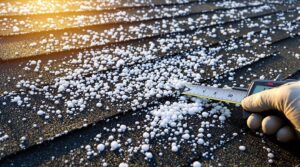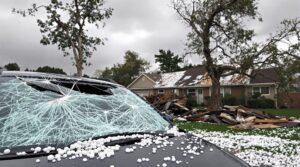Hail-related fatalities, while rare in modern times, have occurred throughout history. Since 2000, four documented deaths from hail have been recorded in the United States, with the most recent in Fort Worth, Texas (2008). The 1888 Moradabad disaster in India claimed 246 lives, while a 14th-century hailstorm reportedly killed 10,000 English soldiers. Contemporary hail damage primarily affects property, causing $8-14 billion in annual losses. Understanding hail's complex dynamics reveals critical safety considerations.
Key Takeaways
- Four people have died from hail in the United States since 2000, with the most recent death occurring in Fort Worth, Texas.
- The deadliest hail event in recorded history occurred in 1888 in Moradabad, India, killing 246 people.
- A devastating 14th-century hailstorm reportedly killed 10,000 English soldiers during the Hundred Years War.
- Eight people died in a 1784 South Carolina hailstorm, which also caused significant livestock losses.
- The United States has recorded only eight hail-related deaths since 1942, despite billions in annual property damage.
The Reality of Hail-Related Deaths in America
Only four hail-related fatalities have occurred in the United States since 2000, highlighting the relatively low mortality risk from this meteorological phenomenon. The distribution of these hail fatalities trends shows two deaths in 2000, followed by single incidents in 2005 and 2008, with the most recent occurrence documented in Fort Worth, Texas.
Despite the infrequency of fatalities, hail continues to pose considerable risks, causing an average of 24 injuries annually across the country. These statistics underscore the importance of outdoor safety precautions, particularly in high-risk states such as Texas, Nebraska, and Colorado.
Analysis indicates that mortality and injury risks increase markedly when individuals are caught outdoors without adequate shelter during hailstorms.
The contrast between U.S. statistics and historical events, such as India's 1888 hailstorm that claimed 246 lives, demonstrates how modern warning systems and public awareness have effectively reduced fatality rates in developed nations.
Deadliest Hailstorms Throughout History
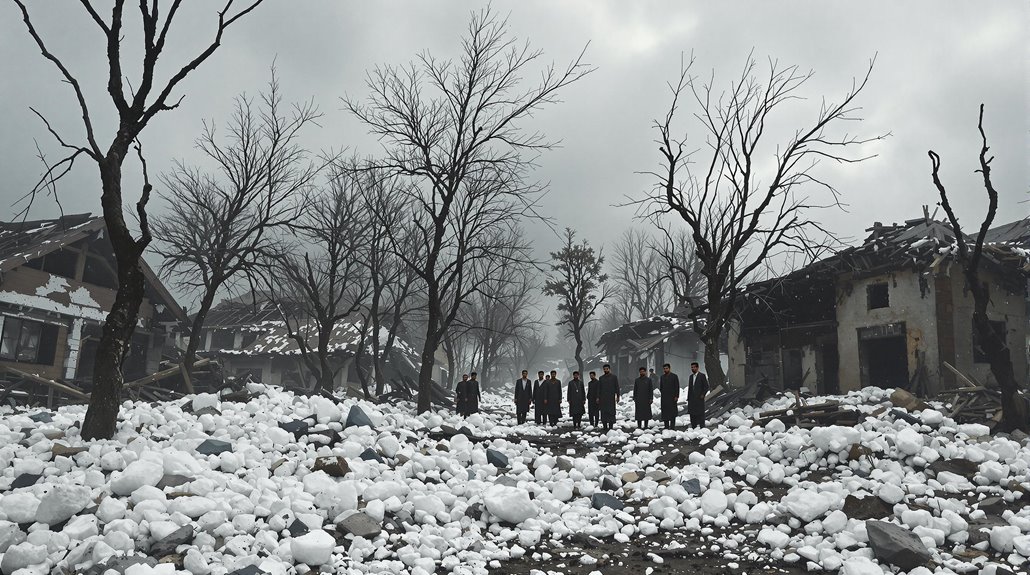
The historical record of deadly hailstorms reveals a stark contrast between pre-modern and contemporary casualties, with the 1888 Moradabad disaster in India claiming 246 lives representing the most well-documented single-event tragedy.
Historical hailstorm impacts reached their apex during the 14th century when an intense hailstorm reportedly killed 10,000 English soldiers during the Hundred Years War, though documentation from this era remains limited.
Notable hailstorm events in rural regions have historically produced higher fatality rates due to inadequate infrastructure and warning systems. This pattern emerged clearly in the 1784 South Carolina incident, where eight individuals perished alongside numerous livestock.
Modern statistics demonstrate a significant reduction in hail-related fatalities, particularly in developed nations. Since 1942, the United States has recorded only eight deaths from hail, despite experiencing over $22 billion in hail-related damages in 2017 alone, highlighting the effectiveness of contemporary warning systems and protective infrastructure.
Understanding the True Dangers of Hail
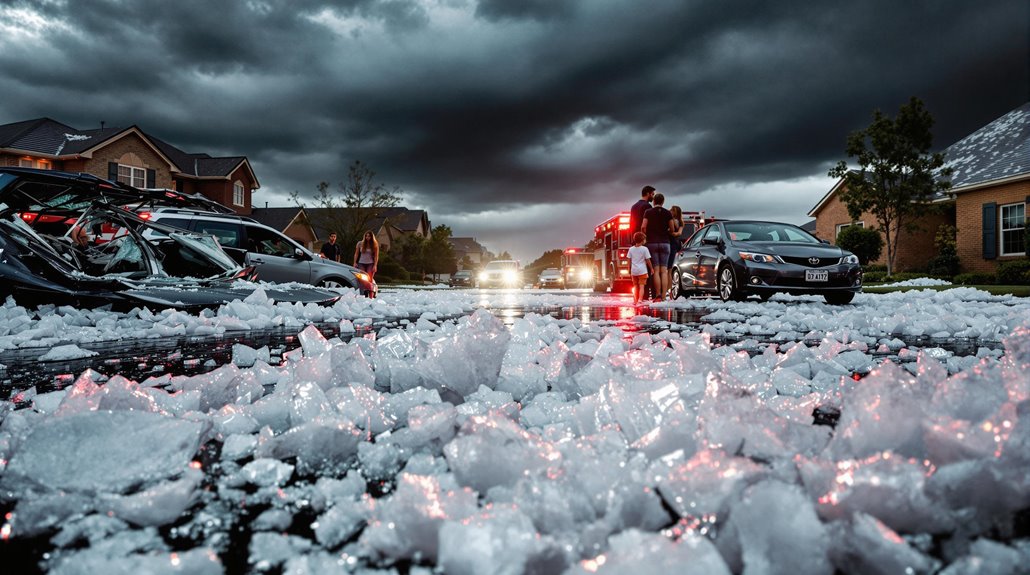
Modern hail damage presents a significant economic burden, with annual costs ranging from $8-14 billion across property, infrastructure, and agricultural sectors. The economic impact is particularly severe in regions like "Hail Alley," where cold upper atmospheric conditions facilitate hail formation more frequently than other areas.
While hail formation can produce stones ranging from 0. 25 to over 8 inches in diameter, falling at speeds exceeding 80 mph, human fatalities remain remarkably rare. Since 1942, only eight deaths have been recorded in the United States, with the last occurring in 2000. Meteorologists attribute this low fatality rate to the relatively small size and short duration of most hailstorms, which often pass quickly and allow individuals to seek shelter. The world’s largest hailstone recorded was an astonishing 8 inches in diameter, weighing nearly 2. 5 pounds, and fell in South Dakota in 2010. Despite the potential destructiveness of hail, with damage to crops and property, human casualties remain an incredibly rare outcome.
However, the destructive potential is evident in property damage statistics, with 6.8 million US properties affected in 2021 alone. Texas bears a disproportionate burden, accounting for $5.1 billion in damages that year.
Insurance claims continue to rise, with State Farm reporting $3.5 billion in hail-related claims.
Essential Safety Measures During Hailstorms
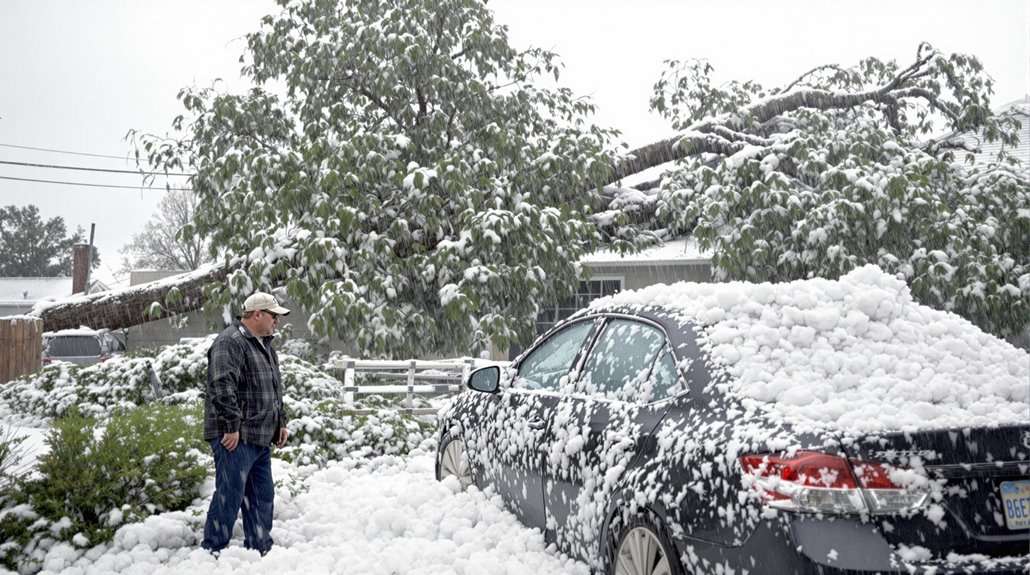
Implementing thorough safety protocols during hailstorms requires a systematic approach across three distinct phases: pre-storm preparation, active storm response, and post-event assessment.
Effective hailstorm preparedness encompasses structural fortification, vehicular protection, and personal safety measures.
Key hail safety tips for peak protection include:
- Installing impact-resistant roofing materials and maintaining clear eavestroughs
- Securing outdoor assets and trimming hazardous vegetation
- Positioning vehicles at advantageous angles during storms, with hail impact directed toward reinforced windshields
- Documenting damage systematically for insurance purposes
During active hailstorms, individuals should remain indoors, avoiding windows and glass surfaces.
Vehicle operators must reduce speed and seek appropriate shelter, avoiding overpasses and low-lying areas.
Post-storm protocols necessitate immediate damage assessment, temporary repairs, and careful monitoring of utilities, particularly gas systems.
Emergency lighting should utilize battery-powered sources rather than open flames to minimize secondary hazards.
Weather Patterns and Hail Formation
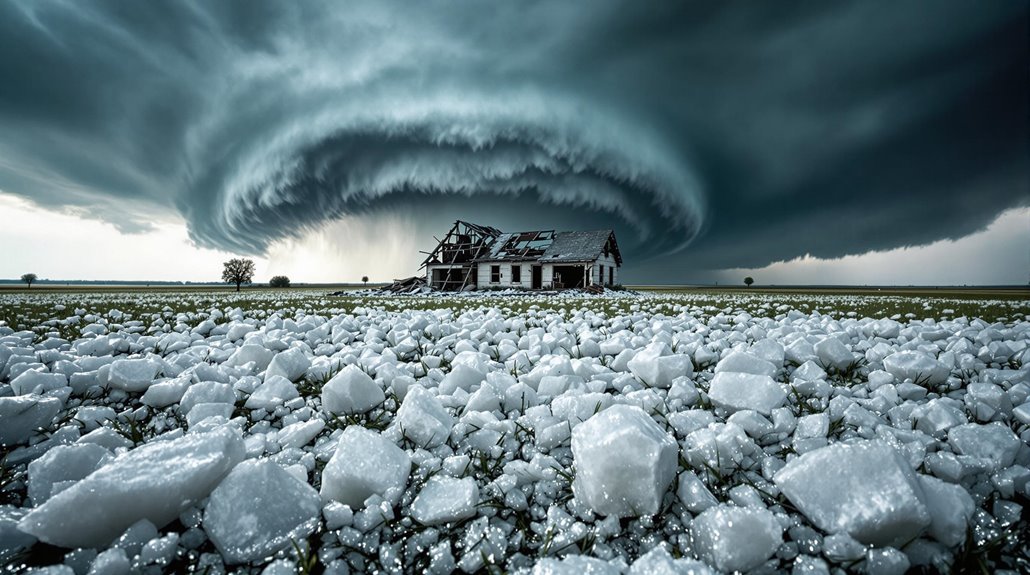
Understanding hail formation requires examination of complex atmospheric interactions that occur during severe weather events. The process initiates when unstable air creates powerful updrafts within thunderstorm clouds, particularly in supercell systems where rotating updrafts maintain suspended water droplets in subfreezing temperatures.
Weather patterns conducive to hail formation typically involve the convergence of distinct air masses and specific atmospheric conditions. Supercell thunderstorms, characterized by their rotating updrafts, provide ideal conditions for hail development. These systems commonly form along frontal boundaries where warm and cold air masses collide, or through orographic lifting when moist air encounters elevated terrain.
The formation process involves multiple cycles of freezing and layering as supercooled water droplets accumulate around ice nuclei. Critical factors influencing hail development include elevation, with favorable conditions occurring where freezing levels remain below 11,000 feet, and wind shear patterns that introduce dry air into the storm system.
The Benefits Of Consulting A Public Adjuster
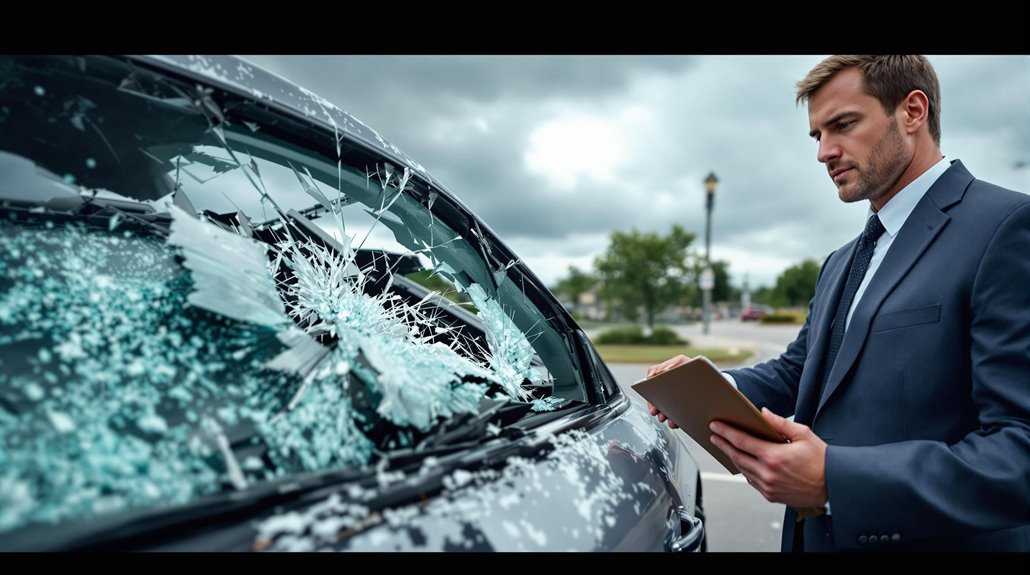
Public adjusters provide critical expertise in maneuvering complex insurance claims related to hail damage, offering objective assessments that document the full scope of property destruction.
These licensed professionals streamline the claims process through thorough documentation, policy interpretation, and skilled negotiation with insurance carriers.
Statistical data indicates that professionally-managed claims typically result in considerably higher settlements compared to self-managed claims, with public adjusters leveraging their specialized knowledge to maximize coverage benefits.
Studies show that engaging a public adjuster can lead to 800% higher settlements when compared to self-managed insurance claims.
Expertise In Insurance Claims
When dealing with hail damage insurance claims, consulting a public adjuster offers significant advantages due to their specialized expertise and extensive understanding of the claims process.
These professionals excel in insurance policy interpretation and implement effective claims negotiation strategies to maximize settlements for policyholders.
Their thorough expertise encompasses:
- Policy analysis and identification of all covered losses
- Documentation preparation and damage assessment coordination
- Strategic negotiation with insurance carriers
- Management of complex paperwork and settlement processes
Public adjusters meticulously document hail damage, prepare detailed loss assessments, and present thorough claims to insurance companies.
Their professional knowledge enables them to challenge undervalued settlements and guarantee policyholders receive fair compensation while reducing the time and stress associated with the claims process.
Unlike insurance company adjusters who must follow company financial interests, public adjusters work solely to advocate for the policyholder's maximum benefit.
Objective Damage Assessment
Professional objective damage assessment through a public adjuster provides property owners with detailed documentation and evaluation of hail-related impacts.
These independent specialists conduct extensive damage evaluations utilizing advanced roofing and meteorological technology to identify both visible and concealed structural impairments.
Public adjusters leverage their specialized knowledge of various property damage types, including hail, wind, and subsequent water intrusion, to maximize insurance compensation.
Their unbiased representation guarantees detailed documentation of all applicable damages, from cosmetic denting to severe structural compromises.
During insurance negotiation, they quantify damages and collaborate with contractors to develop thorough restoration plans that meet insurance requirements.
This expertise proves particularly valuable when addressing claim disputes, denials, or instances of inadequate compensation from insurance providers.
Licensed professionals must maintain complete independence from insurance companies while serving as advocates for homeowners throughout the claims process.
Streamlined Claim Process
A streamlined insurance claims process represents one of the primary advantages of engaging a public adjuster for hail damage assessment. Through efficient negotiations and management of streamlined paperwork, these professionals greatly reduce the complexity of insurance claims while maximizing potential settlements.
Key benefits of public adjuster involvement include:
- Documentation enhancement through thorough collection and organization of all required evidence
- Professional communication management with insurance carriers, eliminating miscommunication risks
- Accelerated claim resolution through expert knowledge of policy terms and procedural requirements
- Reduced property owner stress by handling technical aspects of claims processing
Public adjusters leverage their expertise to navigate complex claims procedures, ensuring proper documentation while maintaining effective dialogue with insurance providers.
This systematic approach helps property owners achieve optimal outcomes while focusing on recovery efforts.
With contingency-based fees standard across most states, property owners can pursue claims without upfront costs while accessing experienced professionals.
Higher Claim Payouts & Settlements
Despite initial hesitation about fees, property owners who engage public adjusters frequently secure substantially higher claim settlements compared to those who process claims independently.
Public adjusters achieve these enhanced outcomes through thorough damage assessment protocols and strategic claim negotiation techniques, leveraging their expertise in policy interpretation and documentation requirements.
Their professional representation includes thorough property evaluations that identify all eligible damages, coupled with skilled negotiations that counter insurance company tactics designed to minimize payouts.
Operating on a contingency fee basis, typically up to 10% of the settlement, adjusters provide their services without upfront costs.
The investment is often justified by the increased settlement amounts, which result from their detailed documentation, expert policy knowledge, and systematic approach to claim valuation and presentation.
When claims become especially complex, public adjuster and attorney collaboration can provide optimal results by combining technical assessment expertise with legal knowledge.
About The Public Claims Adjusters Network (PCAN)
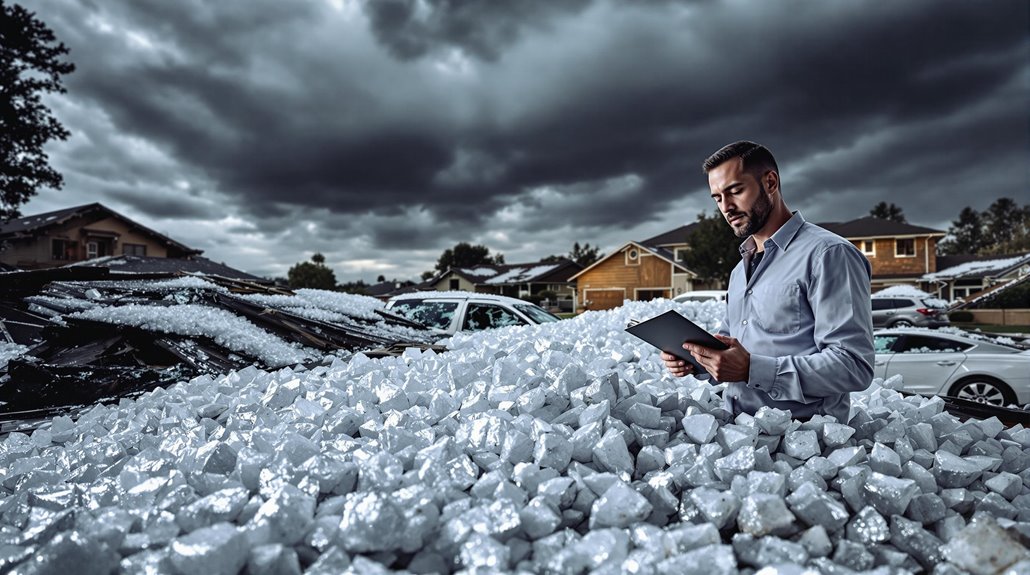
Expertise in insurance claim settlements forms the foundation of the Public Claims Adjusters Network (PCAN), a consortium of licensed public insurance adjusters dedicated to representing policyholder interests.
Operating across multiple states including Texas, Florida, and Oklahoma, PCAN specializes in complex property damage claims, particularly those involving hail damage.
The network delivers four essential public adjuster benefits:
- Professional documentation and analysis of property damage
- Expert policy interpretation and claim negotiation
- Contingency-based fee structure (10-30% of settlement)
- Zero upfront costs with free initial consultations
PCAN maintains strict compliance with state regulations while connecting policyholders to qualified adjusters within their region.
Their adjusters possess specialized knowledge in various claim types, from hail and fire damage to business interruption losses.
This technical expertise, combined with their exclusive representation of policyholder interests, enables them to secure fair settlements without unnecessary litigation.
Frequently Asked Questions
Can Hail Penetrate a Car's Windshield?
Large hailstones can penetrate automotive windshields through severe impact, particularly when exceeding baseball size. The combination of hail impact velocity and density determines the extent of windshield damage.
What's the Average Speed of Falling Hail?
Hail formation occurs at varying altitudes, producing terminal velocities between 9-100 mph, with average speeds of 30-44 mph. Larger hailstones fall faster, increasing potential hail damage to property and structures.
Do Helmets Provide Adequate Protection Against Large Hailstones?
Standard helmets offer limited protection against large hailstones, as most helmet materials aren't specifically engineered to withstand severe hail impact forces exceeding their designed protective capabilities for typical head protection.
How Long Does a Typical Hailstorm Last?
Most hail storms last 5-10 minutes, though duration varies considerably based on storm severity impacts. Supercell thunderstorms can sustain hail production for 20-30 minutes under ideal atmospheric conditions.
Can Weather Radar Accurately Predict Hail Size Before Storms?
Modern hail prediction technology using radar provides estimates but faces accuracy challenges. Radar-derived measurements can overestimate small hail and underestimate severe hail, requiring expert meteorological analysis for reliable predictions.
References
- https://www.accuweather.com/en/weather-news/what-are-your-chances-of-being-killed-by-hail-in-the-us/333722
- https://dokumen.pub/writing-and-reading-across-the-curriculum-rental-edition-14nbsped-0134668510-9780134668512.html
- https://sciencepolicy.colorado.edu/socasp/weather1/changnon.html
- https://archive.org/stream/criticalthinking_201912/Critical Thinking_djvu.txt
- https://insuranceindustryblog.iii.org/hail-the-death-by-1000-paper-cuts-peril/
- https://www.collisioncraftsman.com/the-worst-hail-storms-in-history
- https://dentguys.com/tdg-media/articles/what-you-may-not-know-about-hail/
- https://www.youtube.com/watch?v=5AVkBqHcSFg
- https://www.businessinsider.nl/worst-hail-storms-in-us-history-2019-10?international=true&r=US
- https://www.carcovers.com/articles/the-22-worst-hailstorms-in-us-history-morgan-taveras

